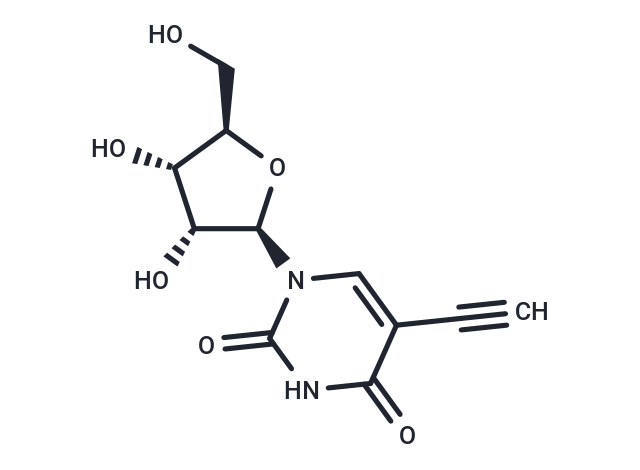Shopping Cart
Remove All Your shopping cart is currently empty
Your shopping cart is currently empty
5-Ethynyluridine can be used to label newly synthesized RNA. This approach, named capture of the newly transcribed RNA interactome using click chemistry (RICK), systematically captures proteins bound to a wide range of RNAs, including nascent RNAs and traditionally neglected nonpolyadenylated RNAs.

| Pack Size | Price | USA Warehouse | Global Warehouse | Quantity |
|---|---|---|---|---|
| 5 mg | $47 | In Stock | In Stock | |
| 10 mg | $80 | In Stock | - | |
| 25 mg | $148 | In Stock | - | |
| 50 mg | $263 | 4-6 weeks | 4-6 weeks | |
| 100 mg | $382 | 4-6 weeks | 4-6 weeks | |
| 200 mg | $573 | 4-6 weeks | 4-6 weeks | |
| 1 mL x 10 mM (in DMSO) | $52 | In Stock | In Stock |
| Description | 5-Ethynyluridine can be used to label newly synthesized RNA. This approach, named capture of the newly transcribed RNA interactome using click chemistry (RICK), systematically captures proteins bound to a wide range of RNAs, including nascent RNAs and traditionally neglected nonpolyadenylated RNAs. |
| In vivo | EU labelling can be used to examine transcription in vivo in mouse models of nervous system disorders. Injection of EU directly into the cerebellum results in reproducible labelling of newly transcribed RNA in cerebellar neurons and glia, with cell type-specific differences in relative labelling intensities, such as Purkinje cells exhibiting the highest levels. EU-labelling accumulating into cytoplasmic inclusions, indicating that EU, like other modified uridines, may introduce non-physiological properties in labelled RNAs[1]. |
| Molecular Weight | 268.22 |
| Formula | C11H12N2O6 |
| Cas No. | 69075-42-9 |
| Smiles | OC[C@H]1O[C@H]([C@H](O)[C@@H]1O)n1cc(C#C)c(=O)[nH]c1=O |
| Relative Density. | 1.67 g/cm3 (Predicted) |
| Storage | Powder: -20°C for 3 years | In solvent: -80°C for 1 year | Shipping with blue ice/Shipping at ambient temperature. | |||||||||||||||||||||||||||||||||||||||||||||
| Solubility Information | DMF: 10 mg/mL (37.28 mM), Sonication is recommended. PBS (pH 7.2): 5 mg/mL (18.64 mM), Sonication is recommended. DMSO: 55 mg/mL (205.06 mM), Sonication is recommended. | |||||||||||||||||||||||||||||||||||||||||||||
| In Vivo Formulation | 10% DMSO+40% PEG300+5% Tween-80+45% Saline: 1 mg/mL (3.73 mM), Sonication is recommeded. Please add the solvents sequentially, clarifying the solution as much as possible before adding the next one. Dissolve by heating and/or sonication if necessary. Working solution is recommended to be prepared and used immediately. The formulation provided above is for reference purposes only. In vivo formulations may vary and should be modified based on specific experimental conditions. | |||||||||||||||||||||||||||||||||||||||||||||
Solution Preparation Table | ||||||||||||||||||||||||||||||||||||||||||||||
PBS (pH 7.2)/DMF/DMSO
DMF/DMSO
DMSO
| ||||||||||||||||||||||||||||||||||||||||||||||
| Size | Quantity | Unit Price | Amount | Operation |
|---|

Copyright © 2015-2025 TargetMol Chemicals Inc. All Rights Reserved.